
|

|
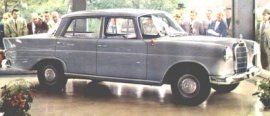 Some 18 months after
the introduction of the first Heckflosse models, Mercedes introduced more Heckflosse
models. In June 1961 production began of the 190 and 190D. To put it very simple, the 190
models were just 220 models but with a 14,5 cm shorter nose. The front of the 190 models
differed from the 220 models as well but the 190 models shared the same interior
measurments as the rest of the 'family' so that was a definite asset. |
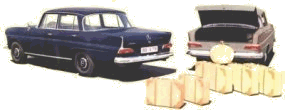 The 190D was especially loved by taxi drivers who, in
comparison with the earlier 190D models, not only found the larger interior an advantage
but also admired the stronger Diesel engine. A special set of six suitcases that were
designed to optimize the boot could be ordered just like the set you order for the other
and more expensive models. The 190D was especially loved by taxi drivers who, in
comparison with the earlier 190D models, not only found the larger interior an advantage
but also admired the stronger Diesel engine. A special set of six suitcases that were
designed to optimize the boot could be ordered just like the set you order for the other
and more expensive models.
|

|
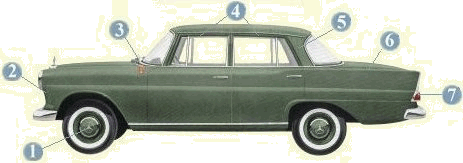
|
  The 190 had similar wheel and hubcaps as
the 220. So again we see the simple wheels with four openings painted in the body colour
and the hubcaps painted also in the body colour. In case the car had a two tone colour
scheme, the colour of the hubcaps would be usually painted in the upper body colour.
|
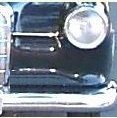  As said above, the front of the 190 models differed
completely from the 220 models. No 'Lichteinheiten' here but simple, round headlights
which made the car look very much like its predecessor. Note the one chrome strip between
the grille and the headlights and the simple bumper. As said above, the front of the 190 models differed
completely from the 220 models. No 'Lichteinheiten' here but simple, round headlights
which made the car look very much like its predecessor. Note the one chrome strip between
the grille and the headlights and the simple bumper.
|
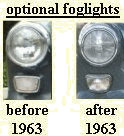 The car could be
equipped with optional foglights placed directly beneath the headlights. After 1963, when
Mercedes gave the cars a small 'face-lift', the shape of the foglights changed slightly to
a more rounded look. The car could be
equipped with optional foglights placed directly beneath the headlights. After 1963, when
Mercedes gave the cars a small 'face-lift', the shape of the foglights changed slightly to
a more rounded look.
It could be my mistake but I haven't found an American car with the 'after 1963' shaped
foglights on neither the 190 models or on the 200 and 230 models in the brochures and
photos of the 1960s.
|
  Typical for the 190 models was the placement of the blinker
lights on the front wings. Cars before 1963 had their rear view mirrors placed on these
blinkers (again very similar to the predecessors). After 1963, these mirrors moved to a
more practical place near the front window. Typical for the 190 models was the placement of the blinker
lights on the front wings. Cars before 1963 had their rear view mirrors placed on these
blinkers (again very similar to the predecessors). After 1963, these mirrors moved to a
more practical place near the front window.
Later 200 and 230 models did not have their blinker lights placed on the wings (see
chapter 7) 1965: The Second Generation: 200, 200D, 230 and 230S,
they were placed beneath the head lights.
|
 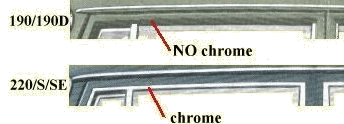 As mentioned in the previous chapter, the use of chrome
was quite different between the 190 models and the 220 models. As mentioned in the previous chapter, the use of chrome
was quite different between the 190 models and the 220 models.
The same difference can be found between later W110 models (the 200, 200D and 230) and the
later W111 (the 230S).
|
  No air outlets for the 190 models, again something that was
left out to keep the price of a 190 model low. The second generation W110 (the 200, 200D
and 230) models did, however, have an air-outlet on the C-pillar. No air outlets for the 190 models, again something that was
left out to keep the price of a 190 model low. The second generation W110 (the 200, 200D
and 230) models did, however, have an air-outlet on the C-pillar.
|
  Here you see where the 220 models looked like the 190
models. Both models had no chrome strip on their 'fins', both models did, however, have
the small strip of chrome on the vertical part of the 'fins'. Later W110 models had no
chrome on their 'fins'. Here you see where the 220 models looked like the 190
models. Both models had no chrome strip on their 'fins', both models did, however, have
the small strip of chrome on the vertical part of the 'fins'. Later W110 models had no
chrome on their 'fins'.
|
 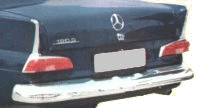 Here you see the resemblance with the 220 models.
Virtually the same rear lights, perhaps they are 100% identical but I can't say for sure.
Again, here are the two numberplate lights placed directly beneath the numberplate,
similar to the 220. Later W110, the 200, 200D and 230, models have a redesigned rear with
more rectangular shaped lights and two horizontal chrome strips. Here you see the resemblance with the 220 models.
Virtually the same rear lights, perhaps they are 100% identical but I can't say for sure.
Again, here are the two numberplate lights placed directly beneath the numberplate,
similar to the 220. Later W110, the 200, 200D and 230, models have a redesigned rear with
more rectangular shaped lights and two horizontal chrome strips.
|
 As said in the previous
chapter, the design of the rear lights of the 190 and of the 220 were changed slightly
during their production life. On the left in the picture you see the early type of rear
light were half of the light 'sticks out' so to speak. On the right you see the newer,
more smoother type of rear light. The red arrow shows the difference between these two
lights. As said in the previous
chapter, the design of the rear lights of the 190 and of the 220 were changed slightly
during their production life. On the left in the picture you see the early type of rear
light were half of the light 'sticks out' so to speak. On the right you see the newer,
more smoother type of rear light. The red arrow shows the difference between these two
lights.
Because I don't know exactly when this change happened, my own guess is
that it happened in 1963. As said above, all models received a small face-lift in 1963. |
The rear lights
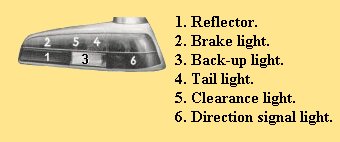
|

|

|
Because the 190 models were virtually a shortened 220, they could
offer the same spacious interior to their occupants as the more expensive 220, 220S and
220SE. The interior appointments were much the same as the 220 models.
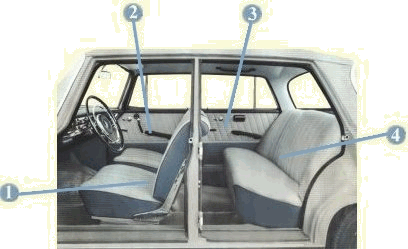
|
  No adjustable back seats for the 190 and 190D unless to
special order of course. You could only moved the seats forward and backward and that's
it, just like on the 220 models. No adjustable back seats for the 190 and 190D unless to
special order of course. You could only moved the seats forward and backward and that's
it, just like on the 220 models.
Of course you could chose between several upholstery options and a central armrest for the
front passengers could be ordered as well.
|
 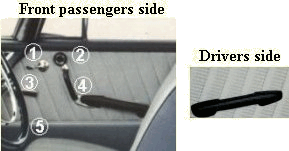 The front passengers side door looks the same as on the
other models. A door opener (no. 1), the knob to open the quarter lights (no. 2), the
window opener with padding of course (no. 3) and the door handle which had the extra
handle only on the passengers side, the drivers side did not have an extended handle. The front passengers side door looks the same as on the
other models. A door opener (no. 1), the knob to open the quarter lights (no. 2), the
window opener with padding of course (no. 3) and the door handle which had the extra
handle only on the passengers side, the drivers side did not have an extended handle.
Note that the 190 models did NOT have doorpockets (no. 5).
|
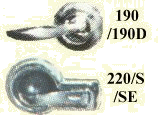 If you look carefully,
you see that the door opener on the 190 models looks different from that found in the 220,
220S and 220SE models. All the photos of the interior of 190 models show these openers.
These openers are the same as Mercedes used on the predeseccor models: the W120 and W121.
Perhaps a way to save on production costs? Later W110 models all had the same recessed
door openers of the 220 models. If you look carefully,
you see that the door opener on the 190 models looks different from that found in the 220,
220S and 220SE models. All the photos of the interior of 190 models show these openers.
These openers are the same as Mercedes used on the predeseccor models: the W120 and W121.
Perhaps a way to save on production costs? Later W110 models all had the same recessed
door openers of the 220 models.
|
 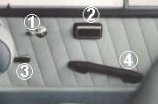 In the back, things were very much the same as the 220. Door
opener (no. 1), ashtray (no. 2), window opener (no. 3) and doorhandle (no. 4) are all
there were you expect them to be. No extended doorhandle here, as on the 220S and SE. In the back, things were very much the same as the 220. Door
opener (no. 1), ashtray (no. 2), window opener (no. 3) and doorhandle (no. 4) are all
there were you expect them to be. No extended doorhandle here, as on the 220S and SE.
|
  To keep down the price of a 190, the backseat did not have a
central armrest unless the customer ordered one. To keep down the price of a 190, the backseat did not have a
central armrest unless the customer ordered one.
|

